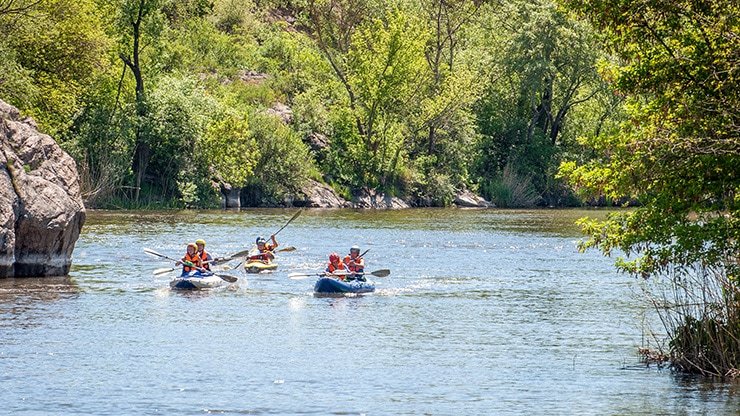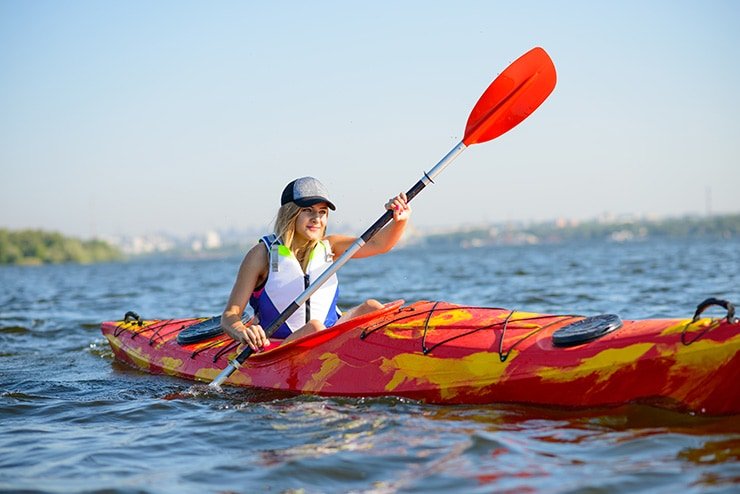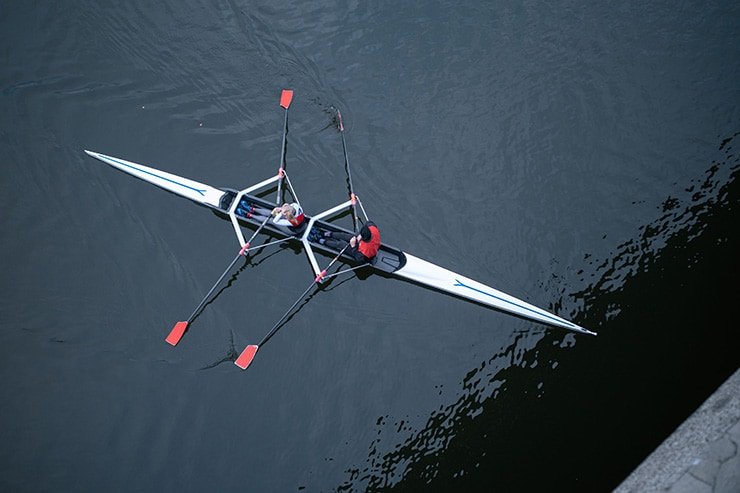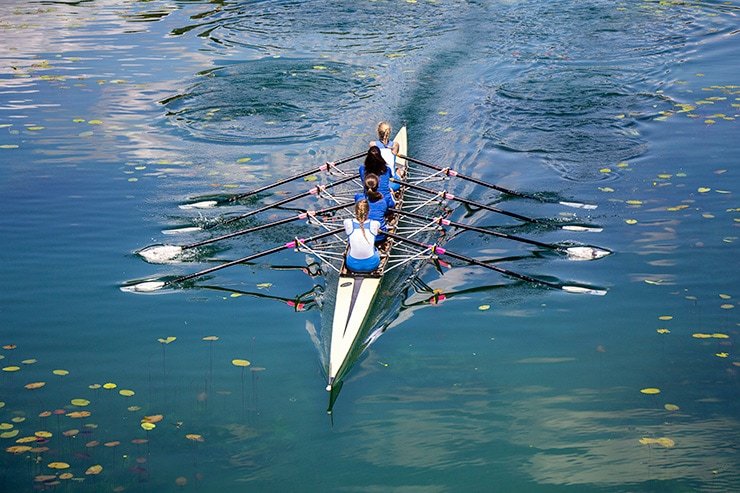Rowing and kayaking have a lot in common – they involve paddles, water, and boats, but both activities differ considerably, aside from a few similarities. In this article, we’ll be pitching rowing vs. kayaking under the spotlight to understand these differences in detail.
Key Takeaways
- Rowing is a competitive sport that originated in England and requires power, stamina, and efficiency. Single-bladed oars are fixed to the boat and rowers move backward.
- Kayaking is a recreational activity that originated with the Inuits and requires balance, control, and adaptability. Double-bladed paddles are held by the kayaker and kayakers move forward.
- Both sports have benefits and drawbacks, such as calorie burning, cardiovascular health, relaxation, and injury risk.
- Rowing is more demanding and expensive, while kayaking is more accessible and versatile.
- Rowing is generally faster than kayaking, but kayaking is easier for beginners and less stressful on the back.
What Is Rowing?
Rowing is a mode of transportation that’s been in use for thousands of years. It most likely originates from propelling large boats and warships across vast distances using bigger rowing crews.
Rowing is often seen as a competition sport – it originated in 16th century England. Wealthier people would often bet on which rowing boats would reach London first, which then gave birth to the sport we know today.
What Is Kayaking?
Like rowing, kayaking is also a mode of transport that’s thousands of years old and is thought to originate with the Inuits.
Kayaks are generally piloted by up to three individuals, and involves paddling using alternating strokes, with a double bladed paddle. Kayaking can also be a competitive water sport but it is more widely regarded as a popular leisure activity.
Kayaking can easily scale to a person’s ability – a beginner can take it easy on a gentle waterway, whereas ocean kayaking in rougher water might challenge the mettle of just about anyone.
There’s arguably a larger number of recreational kayakers than there are rowers – even though you can teach (and learn) rowing more easily, kayaking generally lends itself better towards being an activity that you can socialize around.

The Major Differences Between Rowing and Kayaking
So, other than being on a vessel of some kind and using paddles or oars to propel yourself, where do these two activities differ? Arguably, in just about every other area you could think of.
Equipment
Kayak paddles are double-bladed paddles (there’s a blade on each end) rowing oars have a blade with a handle. This is because the rowing motion used to propel a rowing boat is done with one arm only. Kayaking, on the other hand, always uses both arms and the paddles reflect this.
The design of a rowing oar is based on the fact that it’s fixed to the vessel via an oarlock, meaning it’s longer than a kayak paddle Kayak paddles are generally shorter, as they are designed to be used by paddling on both sides to keep the boat straight, instead of on a single side like rowing oars.
Technique
Both kayaking and rowing make extensive use of the upper body. However, paddling strokes in kayaking tend to involve less motion than rowing. A kayaker is seated in an upright position and constantly ready to switch between each paddle blade – there’s a bit more variation in technique,
Rowers often remain fixed to a bench or slide forward – they mostly row backward in competition, which means they push with their legs and unfold the back to put as much power into each row while making sure not to exhaust themselves too soon.
Body Mechanics
Kayakers and rowers both make extensive use of the upper body, however – kayakers are focused on stabilization, whereas rowers arguably train more for efficiency and pure speed.
Kayak paddle strokes usually make greater use of the deltoids because the paddle is held higher up and a bit closer to the chest. Rowing oars are attached to the boat and make much greater use of the bigger muscles in the back – like the latissimus dorsi (the big muscles in the back) – this is especially true if one rower is manning two oars.
In rowing, the power generation comes from the momentum and big movements from the leg muscles and the back, row boats are often designed to accommodate these sweeping movements.
In Kayaking, a lot of force can be generated by the legs but there’s also an element of balance and control to consider.

Risk of Capsizing
Generally speaking, the likelihood of capsizing on a kayak is higher than on a rowing boat – this is especially true for smaller, one-man kayaks. Some recreational paddling is very unlikely to lead to capsizing, but as you get to more advanced and technical forms of kayaking, there is a much greater emphasis on learning proper recovery skills.
Lower occupancy row boats (one or two persons) can carry the risk of capsizing and can be difficult to recover in – but generally speaking, one-man row boats are much less likely to capsize than kayaks.
The risk also depends on the quality of the vessel – for example, an inflatable kayak is usually much harder to capsize, but it also depends on the conditions of the water you’re on – all bets are off in rougher waters.
Skill Development
Training and development is another important factor to consider when considering rowing vs kayaking – a rowing machine is a very common piece of training equipment in gyms throughout the world and can be a great piece of kit for any budding rower to develop stamina and technique.
Kayaking skills, on the other hand, need time to mature and develop – getting a feel for the water you’re in is important to becoming a strong kayaker. However, at the same time, kayaking is a bit more scalable – to row well you need to be fit – you can take it as easy as you like with a kayak.
Vessel Design
Whether kayak or rowing boat, all small vessels share some common characteristics. However, the differences are equally as pronounced. Rowing boats are much longer and skinnier due to the focus on being streamlined for speed.
Kayak vessels have a lot of variations – your average kayak will be shorter and wider – to help the operator with balance and stability in changing water conditions. However, you can get longer and narrow kayaks that are built for long-distance events.
Kayaks usually have seats that put the operator in an upright position whereas a lot of modern rowing boats have sliding seats to accommodate the rowing motion.

Rowing vs Kayaking: Pros and Cons
| Rowing Pros | Rowing Cons |
| Great for competitive people | Not as laid back |
| Fantastic cardio | Places stress on back and knees |
| Great for burning calories | Not as social |
| Easier to train | Can be monotonous |
Pros of Rowing
Rowing comes with a host of positives. First and foremost, for the type A competitive types who lurk among us – this can be a fantastic way to harness your inner Rocky Balboa and get some serious mileage on the water.
There are a ton of rowing events for all kinds of contenders and it’s a sport that’s stayed relatively popular enough to have a variety of competitions – there’s enough in rowing to keep you invested for a lifetime.
Rowing is fantastic cardio – proper rowing technique ensures you can’t slack off, and so many of the body’s muscles are used that your heart rate is going to go up no matter who you are. An activity like rowing can be a great accessory exercise for any athlete to get some variety in the off-season.
For the reasons mentioned above, rowing can burn a lot of calories. According to Harvard Health, a 155-pound person will burn 369 calories every 30 minutes of vigorous rowing – which makes it one of the biggest calorie burners overall.
Finally, rowing is easier to train – you can go to a gym and just sit on a rowing machine if you like.
Cons of Rowing
There can’t be positives without negatives – this applies to everything, and rowing is no exception. First of all, rowing isn’t necessarily a laid-back activity, even moderate rowing can be surprisingly tiring after a short while.
The things that make rowing so desirable for its training effect also make it a less-than-stellar option as a leisure activity. You can take a leisurely bike ride or a walk, but rowing places certain demands on your body that you can’t work around.
Rowing can place a lot of stress on your back, specifically the lower back or lumbar spine region. Due to the constant folding back to engage your powerful back muscles, you place pressure on your lower back and the constant extension of the knees can also cause wear and tear issues.
Finally, rowing is a very repetitive activity, as there isn’t a ton of variation in the movements, so it can become monotonous. If you’re someone who gets bored on long bike rides, for example, rowing might not be for you.
| Kayaking Pros | Kayaking Cons |
| Can adapt to your skill level | Condition dependant |
| Great to engage with your environment | Hard to gauge progression |
| Fun alone or with friends | Has steep learning curve |
| Great to de-stress | There are some risks |
Pros of Kayaking
Kayaking also has some pretty powerful positives. First of all, it’s quite scalable to anyone, as most people can pick up the absolute bare bones of kayaking within 15 – 30 minutes of instruction.
Kayaking puts you in tune with your environment. A lot of kayaking is about adapting to the water conditions – on calm waters this can feel easy and relaxing but when things get more challenging it forces you to pay attention and be in the moment. This is the kind of challenge that puts most people in the flow state and it’s just plain fun.
Kayaking can be done alone or with friends, some people love the social nature of kayaking and you can take things at your own pace and laugh or turn it into something a bit more competitive – but it’s all in the name of a good time with the people you love.
Kayaking can also be relaxing – it’s not an activity that places strenuous demands on you or else. As long as you do your research and choose easier waterways, kayaking can be incredibly relaxing and a boon for your mental health.

Cons of Kayaking
It’s not all sunshine for kayaking and this leads us to the first point. Kayaking, especially for beginners, can be a bit weather-dependent. If the local hot spots are under siege from high winds, it can quickly obliterate those “take it at your own pace” and “calm and relaxing” benefits.
Kayaking can be easier for beginners than rowing, but if you set your sights on harder forms of kayaking like white water kayaking – things turn up a notch. There’s an element of skill and strength that you’ll need and it can be quite a challenge developing this on your own.
This leads us to our third con – kayaking may be accessible for beginners, but more challenging kayaking events are hard to break into. If your friends aren’t interested in anything beyond the odd recreational kayak then what do you do?
An inexperienced kayaker needs careful guidance when attempting whitewater kayaking for the first time, for example, and also presents quite a high learning curve.
Finally, since kayaking is accessible for beginners, it can give beginners a false sense of confidence. If you overstep your abilities you can get yourself in trouble – especially because kayaking isn’t as strenuous as rowing, going too far out, and getting yourself lost is a possibility.
Is Rowing Faster Than Kayaking?
Yes, rowing is faster than kayaking. Longer oars and vessels that are generally designed around speed give the edge to rowers. Rowing events tend to last longer than kayaking events which can skew the timing, but rowers are practically always faster.
The whole point of a rowing vessel is to transport from A to B as quickly as possible. While there are more and more “high performance” kayaks coming on the market, they still tend to lose out to a row boat maximized for speed.
Is Rowing or Kayaking Better for Your Back?
Overall, kayaking nudges out a victory over rowing here. Kayaking uses very similar muscles to rowing but not with the same intensity. Poor rowing technique also places a lot of strain on the lumbar spine (lower back) and this can contribute to back pain and problems.
Kayaking is much gentler, and the upright motion and seating tend to avoid placing undue stress on one specific point in the back.
Is Rowing Easier Than Kayaking?
It depends, at the higher ends, both sports are very demanding. Rowing will test the stamina of even the fittest Olympians and uses all of the most powerful muscles in the human body. However, high-level kayaking takes a lot of skill and time to master.
In terms of accessibility – kayaking is definitely easier for beginners. This might seem strange to hear because rowing is quite a repetitive motion with little variation, but learning the technique to row powerfully for long periods takes more coaching than most people realize.

Rowing vs Kayaking: Common Injuries in Both Sports
There are common injuries associated with both kayaking and with rowing. The most common of these include:
- Back and knee problems
- Wrist problems
- Shoulder sprains and injuries
Back and knee problems can be a huge issue in athletes who do a ton of rowing. Kayaking tends to be associated with wrist problems, usually due to overuse and repetitive strain. Shoulder sprains and muscle injuries are also fairly common in more challenging forms of kayaking.
Rowing vs Kayaking: Which Is More Expensive?
Rowing as a sport is extremely expensive – the boats and vessels cost money to maintain. It takes a long time to develop rowing skills and techniques and if you don’t maintain the practice, you can lose it easily. Membership fees can be exorbitant, but that depends on where you live.
Kayaking is much cheaper and more accessible. Used kayaks in good condition can cost a few hundred dollars at most – and if well maintained will last for years and years. The more advanced you want to go, the more expensive it becomes. However, for beginners, kayaking is the cheaper option without a doubt.
Conclusion
Kayaking and rowing share some similarities but when you start to take a closer look, the differences between these two activities become quite clear. However, there is a lot to like about both activities, and depending on your personality there is no clear winner about which activity is “best.”
We hope the information here has been useful to you and please comment if you have any more insights into the rowing vs kayaking analysis. Give this article a share if you think someone would enjoy or benefit from the information here.

